Primary and Secondary Branch Growth in Black Spruce and Balsam Fir after Careful Logging around Small Merchantable Stems (CLASS)
Abstract
1. Introduction
2. Materials and Methods
2.1. Experimental Design and Tree Sampling
2.2. Branch Annual Primary Growth (Apical Shoot Length Increment)
2.3. Branch Annual Secondary Growth (Radial Increment)
2.4. Branch Diameter along the Live Crown
2.5. Statistical Analyses
3. Results
3.1. Branch Annual Increment
3.2. Branch Diameter
4. Discussion
4.1. Branch Annual Increment
4.2. Branch Diameter
5. Conclusions
Author Contributions
Funding
Acknowledgments
Conflicts of Interest
References
- Riopel, M.; Bégin, J.; Ruel, J.-C. Probabilités de pertes des tiges individuelles, cinq ans après des coupes avec protection des petites tiges marchandes, dans des forêts résineuses du Québec. Can. J. For. Res. 2010, 40, 1458–1472. [Google Scholar] [CrossRef]
- Ministère des Ressources Naturelles. Coupe avec Protection des Petites Tiges Marchandes (CPPTM)—Avis Scientifique; Comité Consultatif Scientifique du Manuel d’Aménagement Forestier; Gouvernement du Québec, Direction de la Recherche Forestière: Québec, QC, Canada, 2002; 146p.
- Pothier, D.; Doucet, R.; Boily, J. The effect of advance regeneration height on future yield of black spruce stands. Can. J. For. Res. 1995, 25, 536–544. [Google Scholar] [CrossRef]
- Lemay, A.; Krause, C.; Achim, A.; Bégin, J. Growth and wood quality of black spruce and balsam fir following careful logging around small merchantable stems (CLASS) in the boreal forest of Quebec, Canada. Forestry 2018, 91, 271–282. [Google Scholar] [CrossRef]
- Lemay, A.; Krause, C.; Rossi, S.; Achim, A. Xylogenesis in stems and roots after thinning in the boreal forest of Quebec, Canada. Tree Physiol. 2017, 37, 1554–1563. [Google Scholar] [CrossRef] [PubMed]
- Pamerleau-Couture, É.; Krause, C.; Pothier, D.; Weiskittel, A.R. Effect of three partial cutting practices on stand structure and growth of residual black spruce trees in north-eastern Quebec. Forestry 2015, 88, 471–483. [Google Scholar] [CrossRef]
- Baldwin, V.C.; Peterson, K.D.; Clark, A.; Ferguson, R.B.; Strub, M.R.; Bower, D.R. The effects of spacing and thinning on stand and tree characteristics of 38-year-old Loblolly Pine. For. Ecol. Manag. 2000, 137, 91–102. [Google Scholar] [CrossRef]
- Mäkinen, H.; Hein, S. Effect of wide spacing on increment and branch properties of young Norway spruce. Eur. J. For. Res. 2006, 125, 239–248. [Google Scholar] [CrossRef]
- Zhang, S.Y.; Chauret, G.; Ren, H.Q.; Desjardins, R. Impact of initial spacing on plantation black spruce lumber grade yield, bending properties, and MSR yield. Wood Fiber Sci. 2002, 34, 460–475. [Google Scholar]
- Niinemets, Ü.; Lukjanova, A. Needle longevity, shoot growth and branching frequency in relation to site fertility and within-canopy light conditions in Pinus sylvestris. Ann. For. Sci. 2003, 30, 195–208. [Google Scholar] [CrossRef]
- Jozsa, L.A.; Middleton, G.R. A Discussion of Wood Quality Attributes and Their Practical Implications; Special Publication No. SP-34; Forintek Canada Corp.: Vancouver, BC, Canada, 1994; 42p. [Google Scholar]
- MacDonald, E.; Hubert, J. A review of the effects of silviculture on timber quality of Sitka spruce. Forestry 2002, 75, 107–138. [Google Scholar] [CrossRef]
- Weiskittel, A.R.; Seymour, R.S.; Hofmeyer, P.V.; Kershaw, J.A. Modelling primary branch frequency and size for five conifer species in Maine, USA. For. Ecol. Manag. 2010, 259, 1912–1921. [Google Scholar] [CrossRef]
- Hein, S.; Makinen, H.; Yue, C.F.; Kohnle, U. Modelling branch characteristics of Norway spruce from wide spacings in Germany. For. Ecol. Manag. 2007, 242, 155–164. [Google Scholar] [CrossRef]
- Auty, D.; Weiskittel, A.R.; Achim, A.; Moore, J.R.; Gardiner, B.A. Influence of early re-spacing on Sitka spruce branch structure. Ann. For. Sci. 2012, 69, 93–104. [Google Scholar] [CrossRef]
- Grace, J.C.; Brownlie, R.K.; Kennedy, S.G. The influence of initial and post-thinning stand density on Douglas-fir branch diameter at two sites in New Zealand. N. Z. J. Forest. Sci. 2015, 45, 14. [Google Scholar] [CrossRef][Green Version]
- Wang, C.-S.; Tang, C.; Hein, S.; Guo, J.-J.; Zhao, Z.-G.; Zeng, J. Branch development of five-year-old Betula alnoides plantations in response to planting density. Forests 2018, 9, 42. [Google Scholar] [CrossRef]
- Viereck, L.A.; Johnston, W.F. Picea mariana (Mill.) B. S. P. Black spruce. In Silvics of North America, Volume 1: Conifers; Burns, R.M., Honkala, B.H., Eds.; Agriculture Handbook 654; U.S. Department of Agriculture, Forest Service: Washington, DC, USA, 1990; Volume 1, pp. 227–237. [Google Scholar]
- Zhang, S.Y.; Koubaa, A. Softwoods of Eastern Canada: Their Silvics, Characteristics, Manufacturing and End-Uses; FPInnovations: Quebec, QC, Canada, 2008; 363p. [Google Scholar]
- Sullivan, J.H.; Peterson, K.M. The importance of seedling competition in the segregation of spruce and fir in the southern Appalachians. New For. 1994, 8, 105–121. [Google Scholar] [CrossRef]
- Frank, R.M. Abies balsamea (L.) Mill. Balsam fir. In Silvics of North America, Volume 1: Conifers; Burns, R.M., Honkala, B.H., Eds.; Agriculture Handbook 654; U.S. Department of Agriculture, Forest Service: Washington, DC, USA, 1990; Volume 1, pp. 26–35. [Google Scholar]
- Riopel, M.; Bégin, J.; Ruel, J.-C. Coefficients de distribution de la régénération, cinq ans après des coupes avec protection des petites tiges marchandes appliquées dans des sapinières et des pessières noires du Québec. For. Chron. 2011, 87, 669–683. [Google Scholar] [CrossRef]
- Luszczynski, B. Croissance des Branches et des Tiges d’Épinette Noire: Effet de la Tordeuse des Bourgeons de l’Épinette et de l’Éclaircie Commerciale. Master’s thesis, Université du Québec à Chicoutimi, Chicoutimi, QC, Canada, 2009. [Google Scholar]
- Methods of Dendrochronology. Applications in the Environmental Sciences; Cook, E.R., Kairiukstis, L.A., Eds.; Springer Science+Business Media: Dordrecht, The Netherlands, 1990; 394p. [Google Scholar]
- Krause, C.; Luszczynski, B.; Morin, H.; Rossi, S.; Plourde, P.Y. Timing of growth reductions in black spruce stem and branches during the 1970s spruce budworm outbreak. Can. J. For. Res. 2012, 42, 1220–1227. [Google Scholar] [CrossRef]
- Du, S.; Yamamoto, F. An overview of the biology of reaction wood formation. J. Integr. Plant Biol. 2007, 49, 131–143. [Google Scholar] [CrossRef]
- Hein, S.; Weiskittel, A.R.; Kohnle, U. Branch characteristics of widely spaced Douglas-fir in south-western Germany: Comparisons of modelling approaches and geographic regions. For. Ecol. Manag. 2008, 256, 1064–1079. [Google Scholar] [CrossRef]
- Pinheiro, J.; Bates, D.; DebRoy, S.; Sarkar, D.; R Core Team. Package ‘nlme’: Linear and Nonlinear Mixed Effects Models; R Package Version 3.1-137; R Foundation for Statistical Computing: Vienna, Austria, 2018; Available online: https://CRAN.R-project.org/package=nlme (accessed on 8 May 2019).
- R Core Team. R: A Language and Environment for Statistical Computing. R Foundation for Statistical Computing; R Core Team: Vienna, Austria, 2018. [Google Scholar]
- Quinn, G.P.; Keough, M.J. Experimental Design and Data Analysis for Biologists; Cambridge University Press: Cambridge, UK, 2002; 537p. [Google Scholar]
- Hastie, T.J.; Tibshirani, R.J. Generalized Additive Models; Chapman & Hall: London, UK, 1990; 352p. [Google Scholar]
- Rose, N.L.; Yang, H.; Turner, S.D.; Simpson, G.L. An assessment of the mechanisms for the transfer of lead and mercury from atmospherically contaminated organic soils to lake sediments with particular reference to Scotland, UK. Geochim. Cosmochim. Acta 2012, 82, 113–135. [Google Scholar] [CrossRef]
- Wood, S. Package ‘mgcv’: Mixed GAM Computation Vehicle with Automatic Smoothness Estimation; R Package Version 1.8-23; R Foundation for Statistical Computing: Vienna, Austria, 2018; Available online: https://CRAN.R-project.org/package=mgcv (accessed on 8 May 2019).
- Breheny, P.; Burchett, W. Visualization of Regression Models Using visreg. R J. 2017, 9, 56–71. [Google Scholar] [CrossRef]
- Thorpe, H.C.; Thomas, S.C.; Caspersen, J.P. Residual-tree growth responses to partial stand harvest in the black spruce (Picea mariana) boreal forest. Can. J. For. Res. 2007, 37, 1563–1571. [Google Scholar] [CrossRef]
- Hein, S.; Weiskittel, A.R.; Kohnle, U. Effect of wide spacing on tree growth, branch and sapwood properties of young Douglas-fir [Pseudotsuga menziesii (Mirb.) Franco] in south-western Germany. Eur. J. For. Res. 2008, 127, 481–493. [Google Scholar] [CrossRef]
- Forward, D.F.; Nolan, N.J. Growth and morphogenesis in the Canadian forest species. V. Further studies of wood growth in branches and mean axis of Pinus resinosa Ait. under conditions of open growth, suppession, and release. Can. J. Bot. 1961, 39, 413–436. [Google Scholar]
- Mäkinen, H. Effect of stand density on radial growth of branches of Scots pine in southern and central Finland. Can. J. For. Res. 1999, 29, 1216–1224. [Google Scholar] [CrossRef]
- Weiskittel, A.R.; Maguire, D.A.; Monserud, R.A. Modeling crown structural responses to competing vegetation control, thinning, fertilization, and Swiss needle cast in coastal Douglas-fir of the Pacific Northwest, USA. For. Ecol. Manag. 2007, 245, 96–109. [Google Scholar] [CrossRef]
- Mäkinen, H. Effect of stand density on the branch development of silver birch (Betula pendula Roth) in central Finland. Trees-Struct. Funct. 2002, 16, 346–353. [Google Scholar]
- Duchateau, E.; Auty, D.; Mothe, F.; Longuetaud, F.; Ung, C.H.; Achim, A. Models of knot and stem development in black spruce trees indicate a shift in allocation priority to branches when growth is limited. PeerJ 2015, 3, e873. [Google Scholar] [CrossRef]
- Weiskittel, A.R.; Maguire, D.A.; Monserud, R.A. Response of branch growth and mortality to silvicultural treatments in coastal Douglas-fir plantations: Implications for predicting tree growth. For. Ecol. Manag. 2007, 251, 182–194. [Google Scholar] [CrossRef]
- Brix, H. Effects of thinning and nitrogen fertilization on branch and foliage production in Douglas-fir. Can. J. For. Res. 1981, 11, 502–511. [Google Scholar] [CrossRef]
- Benjamin, J.G.; Kershaw, J.A.; Weiskittel, A.R.; Chui, Y.H.; Zhang, S.Y. External knot size and frequency in black spruce trees from an initial spacing trial in Thunder Bay, Ontario. For. Chron. 2009, 85, 618–624. [Google Scholar] [CrossRef]
- Harrington, C.A.; Reukema, D.L. Initial shock and long-term stand development following thinning in a Douglas-fir plantation. For. Sci. 1983, 29, 33–46. [Google Scholar]
- Emmingham, W.H.; Elwood, N.E. Thinning—An Important Timber Management Tool; Pacific Northwest Extension Publication 184; Oregon State University: Corvallis, OR, USA, 1983; 8p. [Google Scholar]
- Jaffe, M.J. Morphogenetic responses of plants to mechanical stimuli or stress. BioScience 1980, 30, 239–243. [Google Scholar] [CrossRef]
- Telewski, F.W.; Jaffe, M.J. Thigmomorphogenesis: Field and laboratory studies of Abies fraseri in response to wind or mechanical perturbation. Physiol. Plant. 1986, 66, 211–218. [Google Scholar] [CrossRef] [PubMed]
- Telewski, F.W.; Jaffe, M.J. Thigmomorphogenesis: Anatomical, morphological and mechanical analysis of genetically different sibs of Pinus taeda in response to mechanical perturbation. Physiol. Plant. 1986, 66, 219–226. [Google Scholar] [CrossRef] [PubMed]
- Valladares, F.; Niinemets, Ü. The Architecture of Plant Crowns: From Design Rules to Light Capture and Performance. In Functional Plant Ecology, 2nd ed.; CRC Press/Taylor & Francis Group: Boca Raton, FL, USA, 2007; pp. 101–149. [Google Scholar]
- Chen, L.; Sumida, A. Effects of light on branch growth and death vary at different organization levels of branching units in Sakhalin spruce. Trees 2018, 32, 1123–1134. [Google Scholar] [CrossRef]
- Peterson, J.A.; Seiler, J.R.; Nowak, J.; Ginn, S.E.; Kreh, R.E. Growth an physiological responses of young loblolly pine stands to thinning. For. Sci. 1997, 43, 529–534. [Google Scholar]
- Tang, Z.; Chambers, J.L.; Guddanti, S.; Barnett, J.P. Thinning, fertilization, and crown position interact to control physiological responses of loblolly pine. Tree Physiol. 1999, 19, 87–94. [Google Scholar] [CrossRef]
- Li, R.-S.; Yang, Q.-P.; Zhang, W.-D.; Zheng, W.-H.; Chi, Y.-G.; Xu, M.; Fang, Y.-T.; Gessler, A.; Li, M.-H.; Wang, S.-L. Thinning effect on photosynthesis depends on needle ages in a Chinese fir (Cunninghamia lanceolata) plantation. Sci. Total Environ. 2017, 580, 900–906. [Google Scholar] [CrossRef]
- Weiskittel, A.R.; Kenefic, L.S.; Seymour, R.S.; Phillips, L.M. Long-term effects of precommercial thinning on the stem dimensions, form and branch characteristics of red spruce and balsam fir crop trees in Maine, USA. Silva. Fenn. 2009, 43, 397–409. [Google Scholar] [CrossRef]
- Bendtsen, B.A. Properties of wood from improved and intensively managed trees. For. Prod. J. 1978, 28, 61–72. [Google Scholar]
- Maguire, D.A.; Kershaw, J.A.; Hann, D.W. Predicting the effects of silvicultural regime on branch size and crown wood core in Douglas-fir. For. Sci. 1991, 37, 1409–1428. [Google Scholar]
- Lowell, E.; Maguire, D.; Briggs, D.; Turnblom, E.; Jayawickrama, K.; Bryce, J. Effects of Silviculture and Genetics on Branch/Knot Attributes of Coastal Pacific Northwest Douglas-Fir and Implications for Wood Quality—A Synthesis. Forests 2014, 5, 1717–1736. [Google Scholar] [CrossRef]
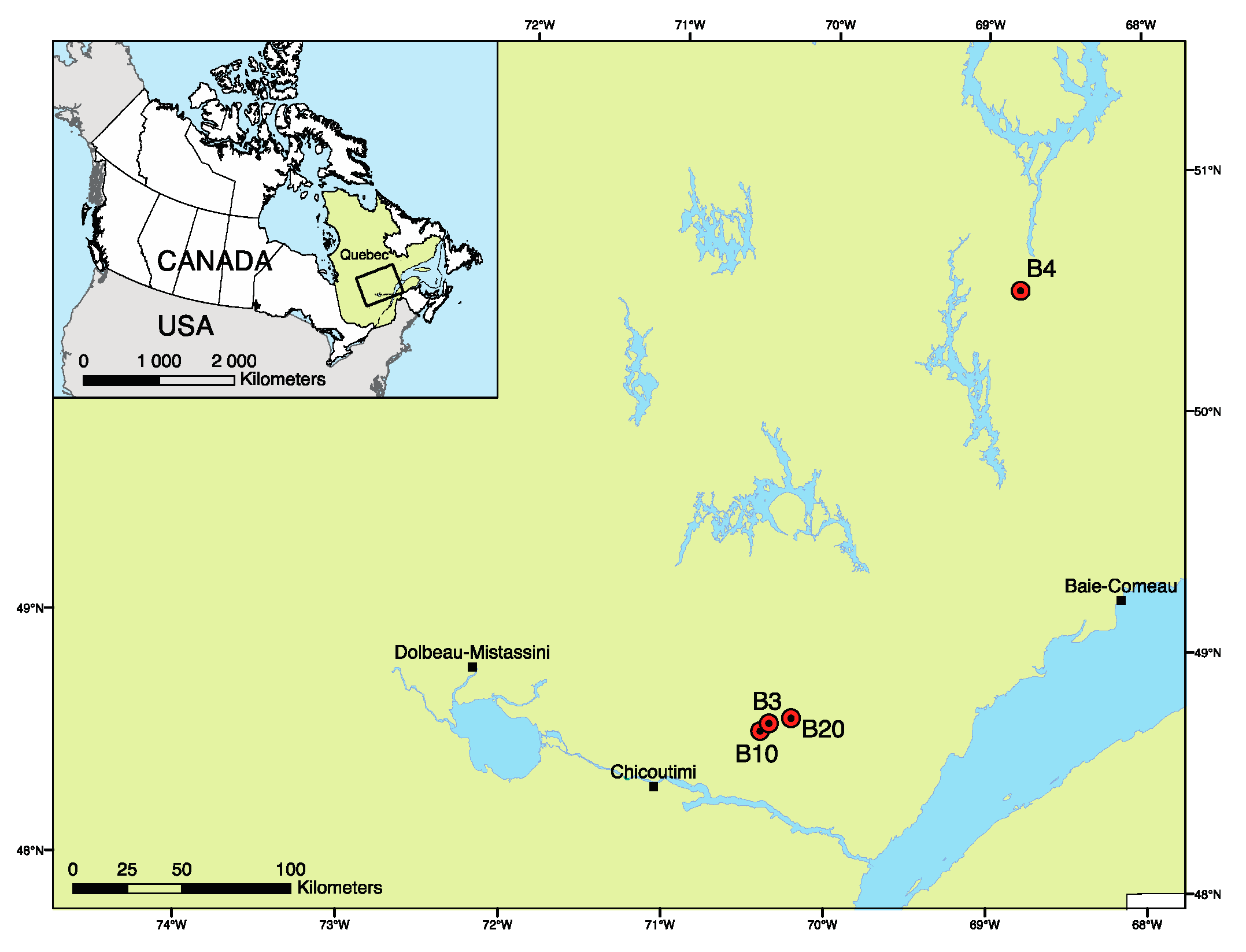
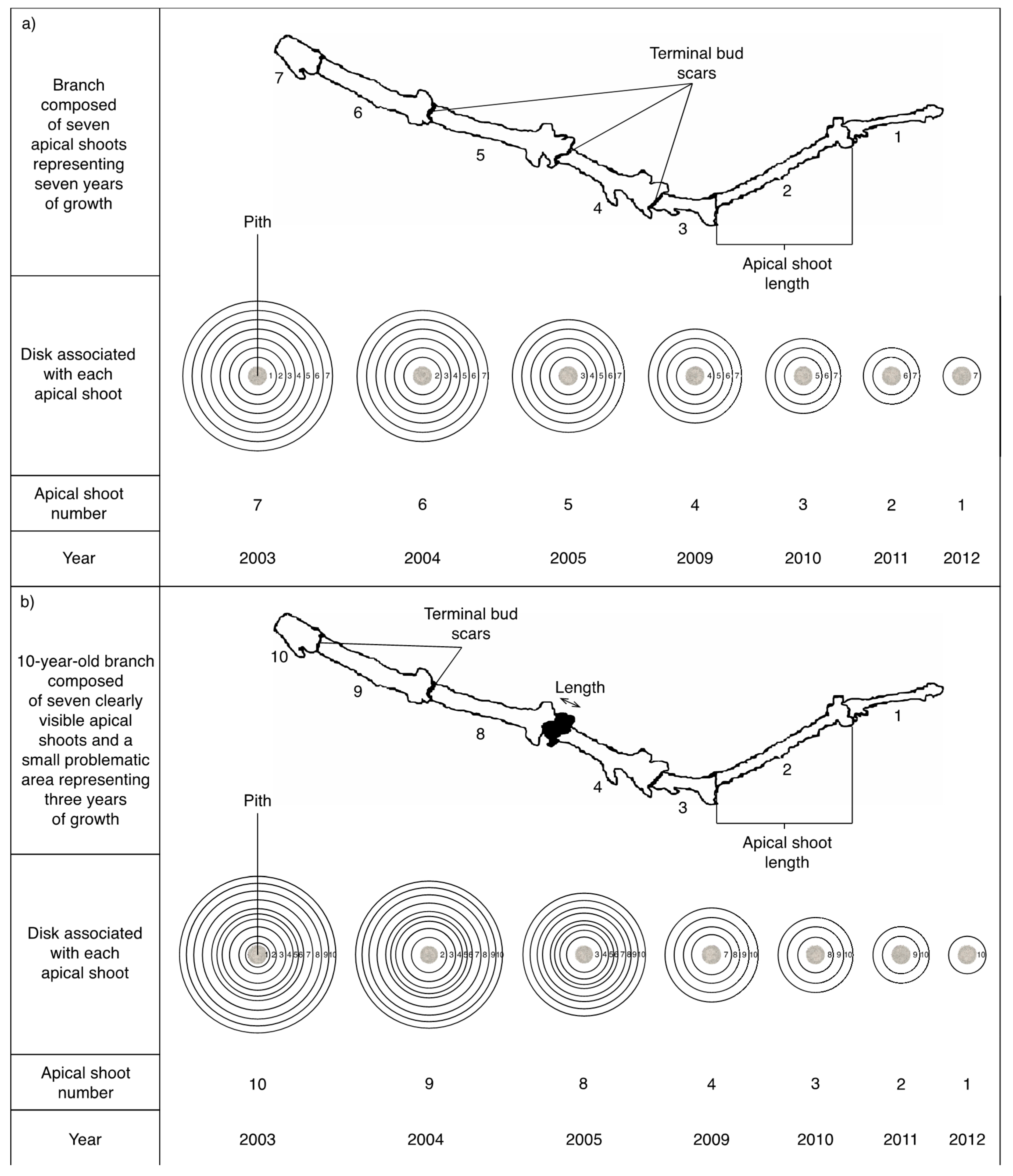
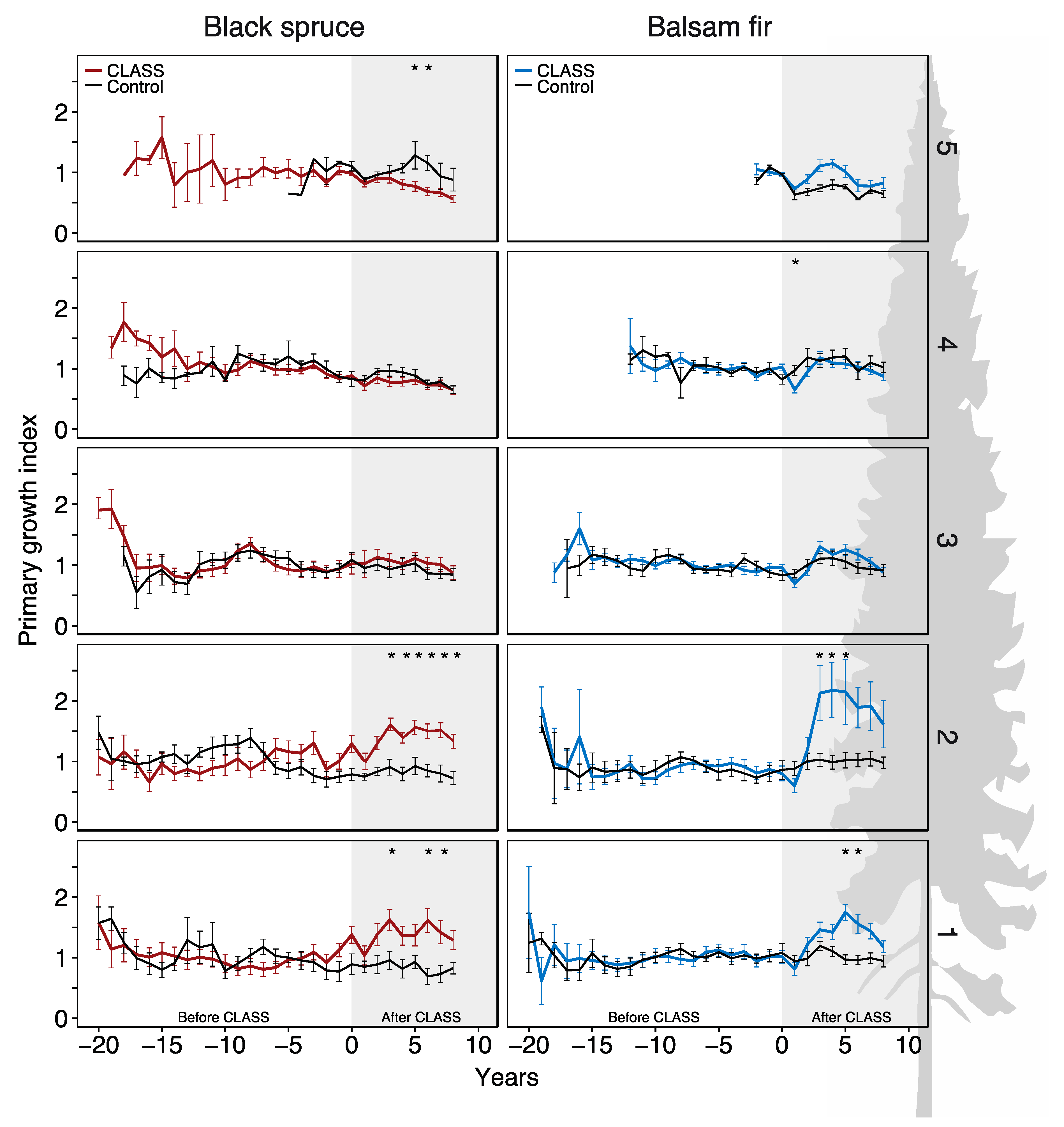
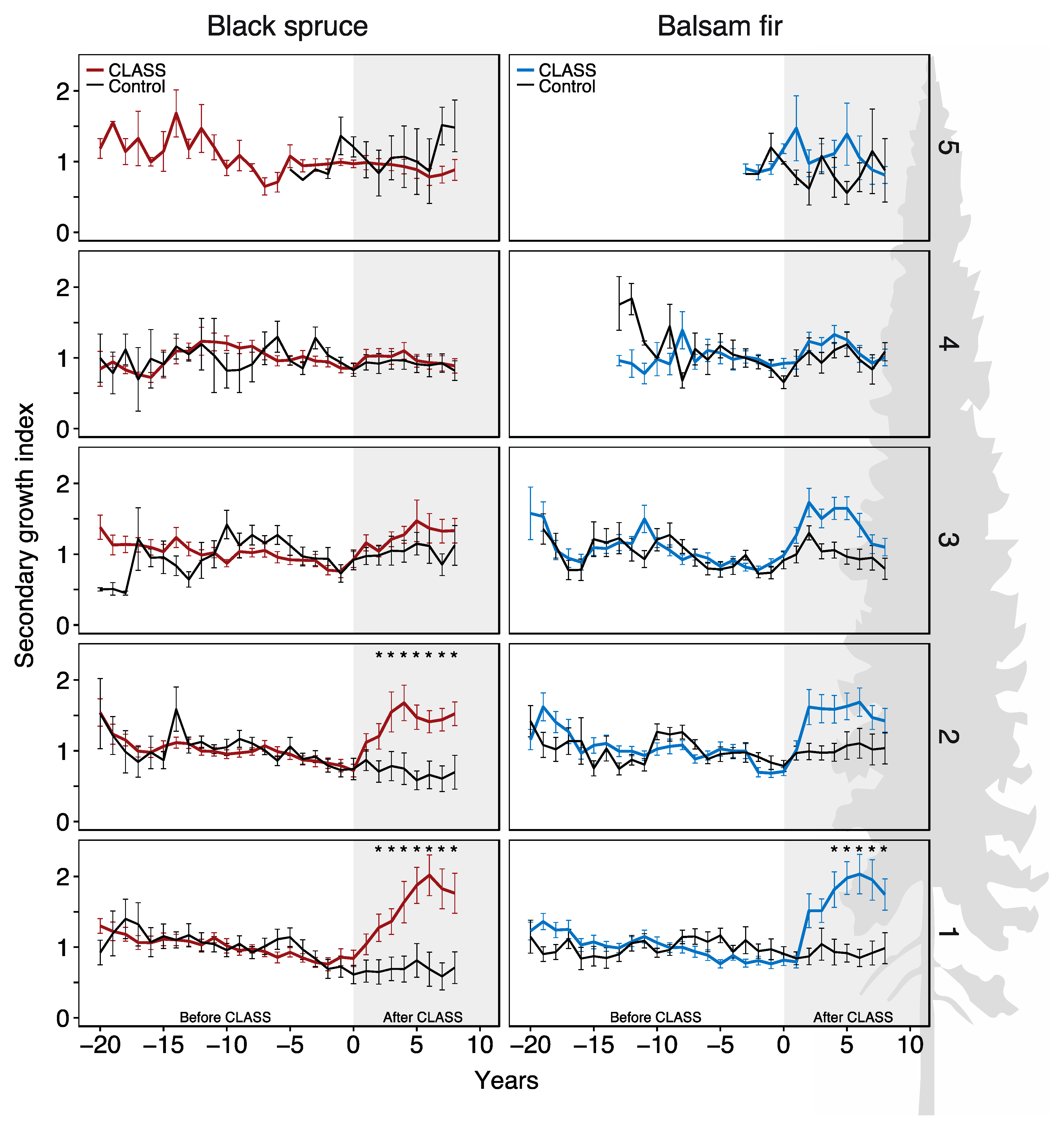
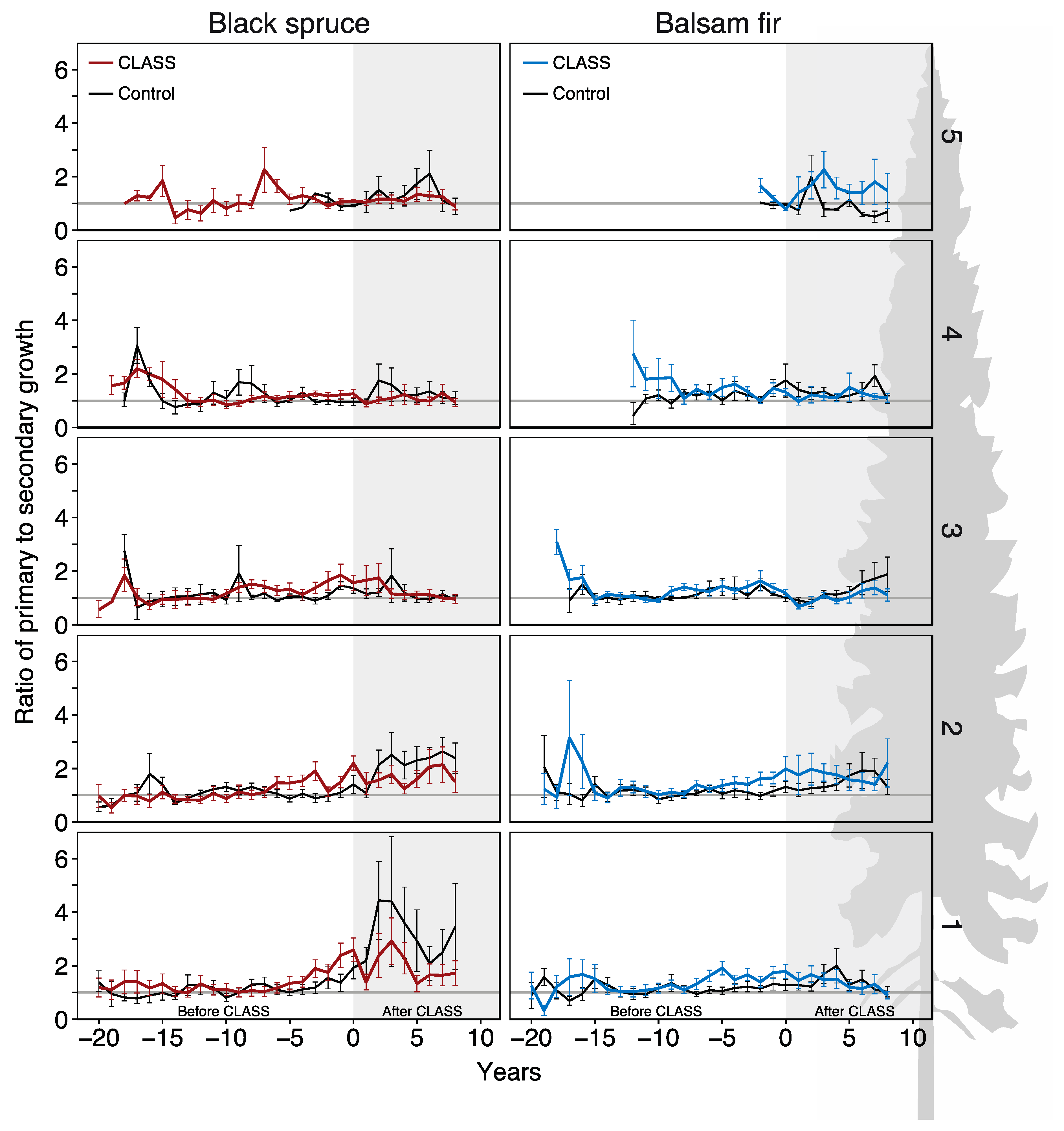
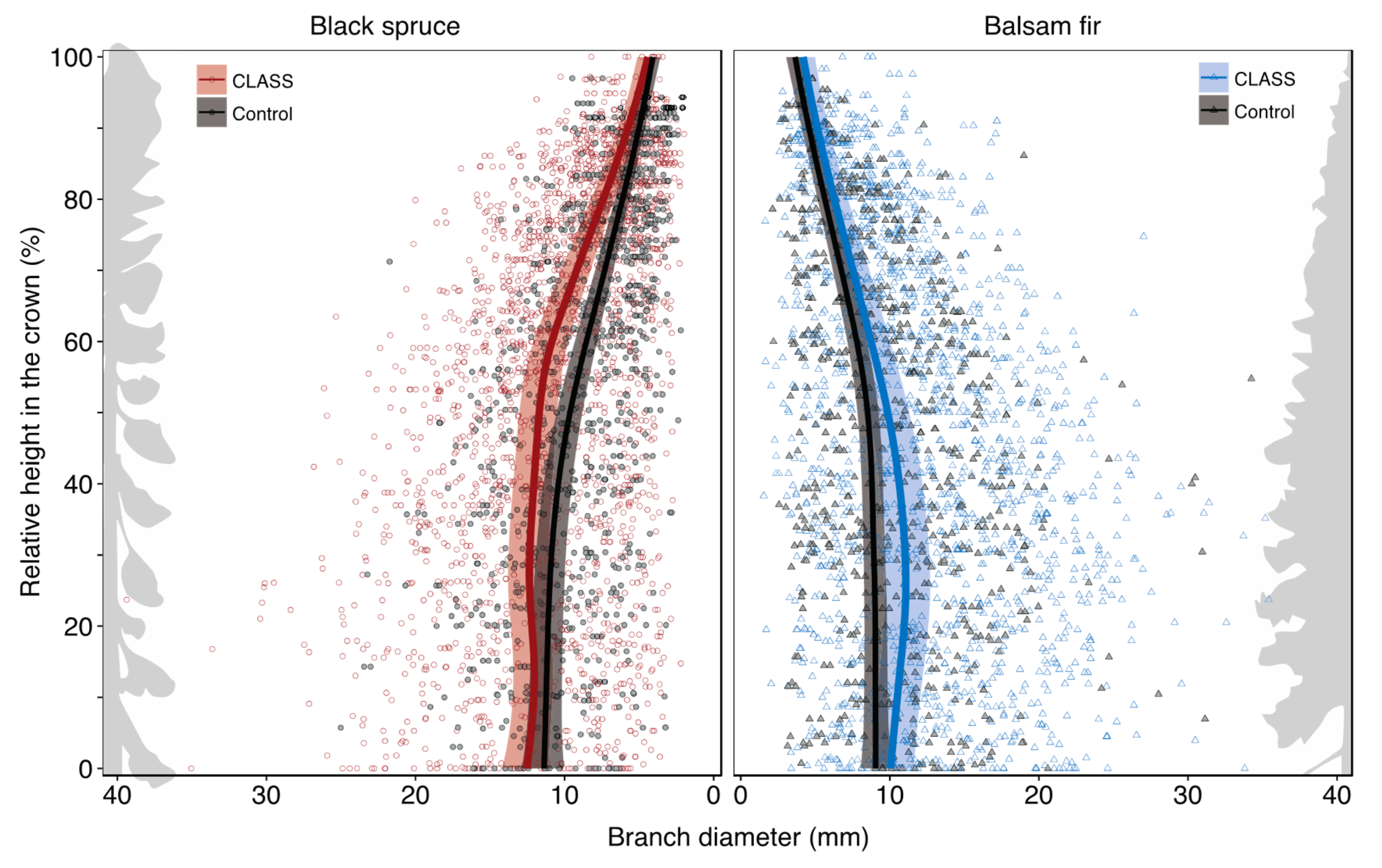
| Before CLASS | After CLASS | ||||||
|---|---|---|---|---|---|---|---|
| Site | Stand Composition | Basal Area (m² ha−1) | Merchantable Density (stems ha−1) | Merchantable Volume (m³ ha−1) | Residual Basal Area (m² ha−1) | Merchantable Volume Harvested (%) | Merchantable Density (stems ha−1) |
| B3 | 74% BS 26% BF | † | 2069 | 145.2 | 10.6 | 79.0 | 652 |
| B4 | 67% BS 33% BF | 26.0 | 1091 | 156.5 | 8.2 | 84.5 | 466 |
| B10 | 62% BS 38% BF | 39.8 | 1947 | 147.0 | 13.4 | 80.0 | 788 |
| B20 | 58% BS 42% BF | 39.4 | 2036 | 132.0 | 16.6 | 72.0 | 1010 |
| Black Spruce | Balsam Fir | ||||||||
|---|---|---|---|---|---|---|---|---|---|
| Site | Treatment | Mean Age (years) | Mean DBH (cm) | Mean Height (m) | Crown Ratio (%) | Mean Age (years) | Mean DBH (cm) | Mean Height (m) | Crown Ratio (%) |
| B3 | CLASS | 85.0 | 12.7 | 9.5 | 58.6 | 104.7 | 12.3 | 7.8 | 55.8 |
| Control | 92.0 | 11.1 | 10.1 | 40.2 | 117.7 | 10.6 | 8.3 | 48.7 | |
| B4 | CLASS | 171.8 | 13.7 | 10.2 | 66.7 | 116.4 | 14.3 | 8.7 | 67.1 |
| Control | 173.0 | 14.2 | 11.3 | 62.1 | 119.7 | 13.1 | 8.2 | 74.1 | |
| B10 | CLASS | 87.2 | 12.9 | 9.0 | 72.6 | 97.9 | 13.3 | 9.5 | 57.2 |
| Control | 90.3 | 11.8 | 9.4 | 59.3 | 100.7 | 11.7 | 9.0 | 53.2 | |
| B20 | CLASS | 126.2 | 13.6 | 10.4 | 64.3 | 123.3 | 11.8 | 8.1 | 58.9 |
| Control | 78.7 | 13.2 | 9.5 | 65.3 | 103.3 | 11.3 | 8.8 | 59.8 | |
| CLASS | 117.6 | 13.2 | 9.8 | 65.5 | 110.6 | 12.9 | 8.5 | 59.7 | |
| Control | 108.5 | 12.6 | 10.1 | 56.7 | 110.3 | 11.7 | 8.6 | 59.0 | |
| Black Spruce | Balsam Fir | |||||||
|---|---|---|---|---|---|---|---|---|
| Crown Section | Source | DF | F | Prob > F | DF | F | Prob > F | |
| Annual primary growth index | Section 5 | Treatment | 1 | 2.05 | 0.1637 | 1 | 5.58 | 0.0457 |
| Year | 7 | 6.84 | <0.0001 | 7 | 6.19 | <0.0001 | ||
| Treatment × Year | 7 | 6.23 | <0.0001 | 7 | 1.23 | 0.3017 | ||
| Section 4 | Treatment | 1 | 1.37 | 0.2479 | 1 | 1.43 | 0.2382 | |
| Year | 7 | 7.26 | <0.0001 | 7 | 8.62 | <0.0001 | ||
| Treatment × Year | 7 | 0.60 | 0.7485 | 7 | 2.56 | 0.0145 | ||
| Section 3 | Treatment | 1 | 0.26 | 0.6124 | 1 | 0.11 | 0.7328 | |
| Year | 7 | 3.07 | 0.0039 | 7 | 11.23 | <0.0001 | ||
| Treatment × Year | 7 | 0.72 | 0.6537 | 7 | 2.55 | 0.0145 | ||
| Section 2 | Treatment | 1 | 6.18 | 0.0172 | 1 | 1.36 | 0.2484 | |
| Year | 7 | 5.73 | <0.0001 | 7 | 12.90 | <0.0001 | ||
| Treatment × Year | 7 | 2.38 | 0.0222 | 7 | 11.70 | <0.0001 | ||
| Section 1 | Treatment | 1 | 4.07 | 0.0499 | 1 | 2.65 | 0.1100 | |
| Year | 7 | 3.84 | 0.0005 | 7 | 5.87 | <0.0001 | ||
| Treatment × Year | 7 | 2.50 | 0.0163 | 7 | 4.32 | 0.0001 | ||
| Annual secondary growth index | Section 5 | Treatment | 1 | 0.15 | 0.6993 | 1 | 1.53 | 0.2556 |
| Year | 7 | 3.96 | 0.0004 | 7 | 1.24 | 0.2913 | ||
| Treatment × Year | 7 | 1.45 | 0.1873 | 7 | 1.22 | 0.3034 | ||
| Section 4 | Treatment | 1 | 0.01 | 0.8977 | 1 | 0.03 | 0.8519 | |
| Year | 7 | 2.46 | 0.0179 | 7 | 3.10 | 0.0037 | ||
| Treatment × Year | 7 | 0.27 | 0.9649 | 7 | 0.48 | 0.8434 | ||
| Section 3 | Treatment | 1 | 0.52 | 0.4737 | 1 | 3.25 | 0.0782 | |
| Year | 7 | 0.95 | 0.4634 | 7 | 7.61 | <0.0001 | ||
| Treatment × Year | 7 | 0.56 | 0.7862 | 7 | 0.67 | 0.6912 | ||
| Section 2 | Treatment | 1 | 16.17 | 0.0002 | 1 | 1.40 | 0.2424 | |
| Year | 7 | 1.71 | 0.1047 | 7 | 2.73 | 0.0090 | ||
| Treatment × Year | 7 | 5.24 | <0.0001 | 7 | 0.98 | 0.4428 | ||
| Section 1 | Treatment | 1 | 10.31 | 0.0026 | 1 | 3.67 | 0.0618 | |
| Year | 7 | 4.79 | <0.0001 | 7 | 10.69 | <0.0001 | ||
| Treatment × Year | 7 | 3.10 | 0.0035 | 7 | 4.26 | 0.0002 | ||
| Black Spruce | Balsam Fir | |||||||
|---|---|---|---|---|---|---|---|---|
| Crown Section | Source | DF | F | Prob > F | DF | F | Prob > F | |
| Ratio of primary to secondary growth | Section 5 | Treatment | 1 | 0.80 | 0.3792 | 1 | 0.01 | 0.9352 |
| Year | 7 | 2.53 | 0.0162 | 7 | 1.20 | 0.3137 | ||
| Treatment × Year | 7 | 0.86 | 0.5408 | 7 | 1.68 | 0.1286 | ||
| Section 4 | Treatment | 1 | 2.05 | 0.1596 | 1 | 2.59 | 0.1158 | |
| Year | 7 | 1.45 | 0.1839 | 7 | 1.48 | 0.1758 | ||
| Treatment × Year | 7 | 0.64 | 0.7196 | 7 | 1.12 | 0.3538 | ||
| Section 3 | Treatment | 1 | 0.07 | 0.7935 | 1 | 3.76 | 0.0591 | |
| Year | 7 | 1.78 | 0.0906 | 7 | 8.12 | <0.0001 | ||
| Treatment × Year | 7 | 0.55 | 0.7936 | 7 | 0.47 | 0.8586 | ||
| Section 2 | Treatment | 1 | 1.85 | 0.1805 | 1 | 0.49 | 0.4886 | |
| Year | 7 | 4.93 | <0.0001 | 7 | 3.69 | 0.0008 | ||
| Treatment × Year | 7 | 0.30 | 0.9522 | 7 | 1.48 | 0.1746 | ||
| Section 1 | Treatment | 1 | 3.71 | 0.0612 | 1 | 2.65 | 0.1112 | |
| Year | 7 | 2.55 | 0.0149 | 7 | 0.89 | 0.5161 | ||
| Treatment × Year | 7 | 0.74 | 0.6348 | 7 | 0.56 | 0.7888 | ||
© 2019 by the authors. Licensee MDPI, Basel, Switzerland. This article is an open access article distributed under the terms and conditions of the Creative Commons Attribution (CC BY) license (http://creativecommons.org/licenses/by/4.0/).
Share and Cite
Lemay, A.; Krause, C.; Achim, A. Primary and Secondary Branch Growth in Black Spruce and Balsam Fir after Careful Logging around Small Merchantable Stems (CLASS). Forests 2019, 10, 500. https://doi.org/10.3390/f10060500
Lemay A, Krause C, Achim A. Primary and Secondary Branch Growth in Black Spruce and Balsam Fir after Careful Logging around Small Merchantable Stems (CLASS). Forests. 2019; 10(6):500. https://doi.org/10.3390/f10060500
Chicago/Turabian StyleLemay, Audrey, Cornelia Krause, and Alexis Achim. 2019. "Primary and Secondary Branch Growth in Black Spruce and Balsam Fir after Careful Logging around Small Merchantable Stems (CLASS)" Forests 10, no. 6: 500. https://doi.org/10.3390/f10060500
APA StyleLemay, A., Krause, C., & Achim, A. (2019). Primary and Secondary Branch Growth in Black Spruce and Balsam Fir after Careful Logging around Small Merchantable Stems (CLASS). Forests, 10(6), 500. https://doi.org/10.3390/f10060500




